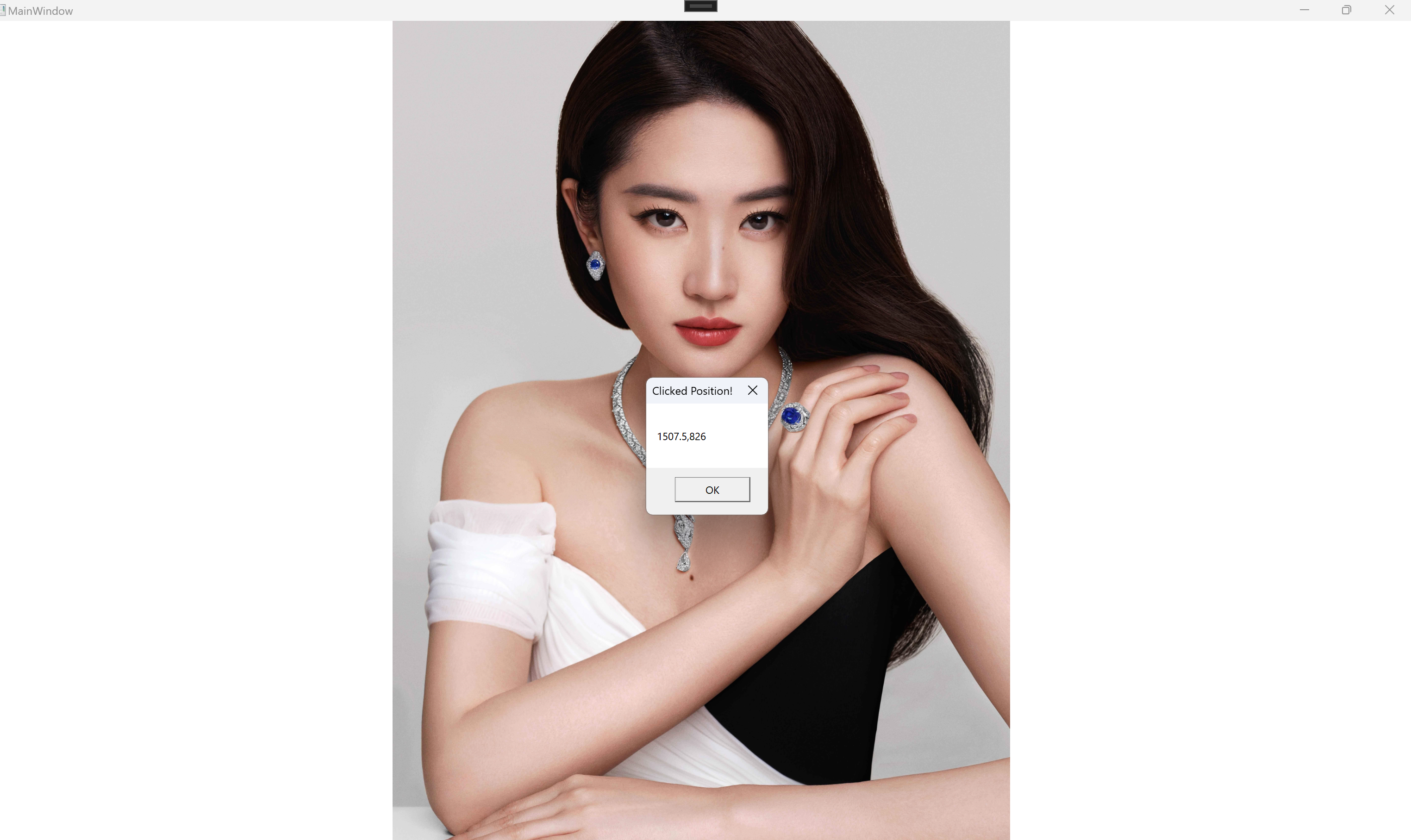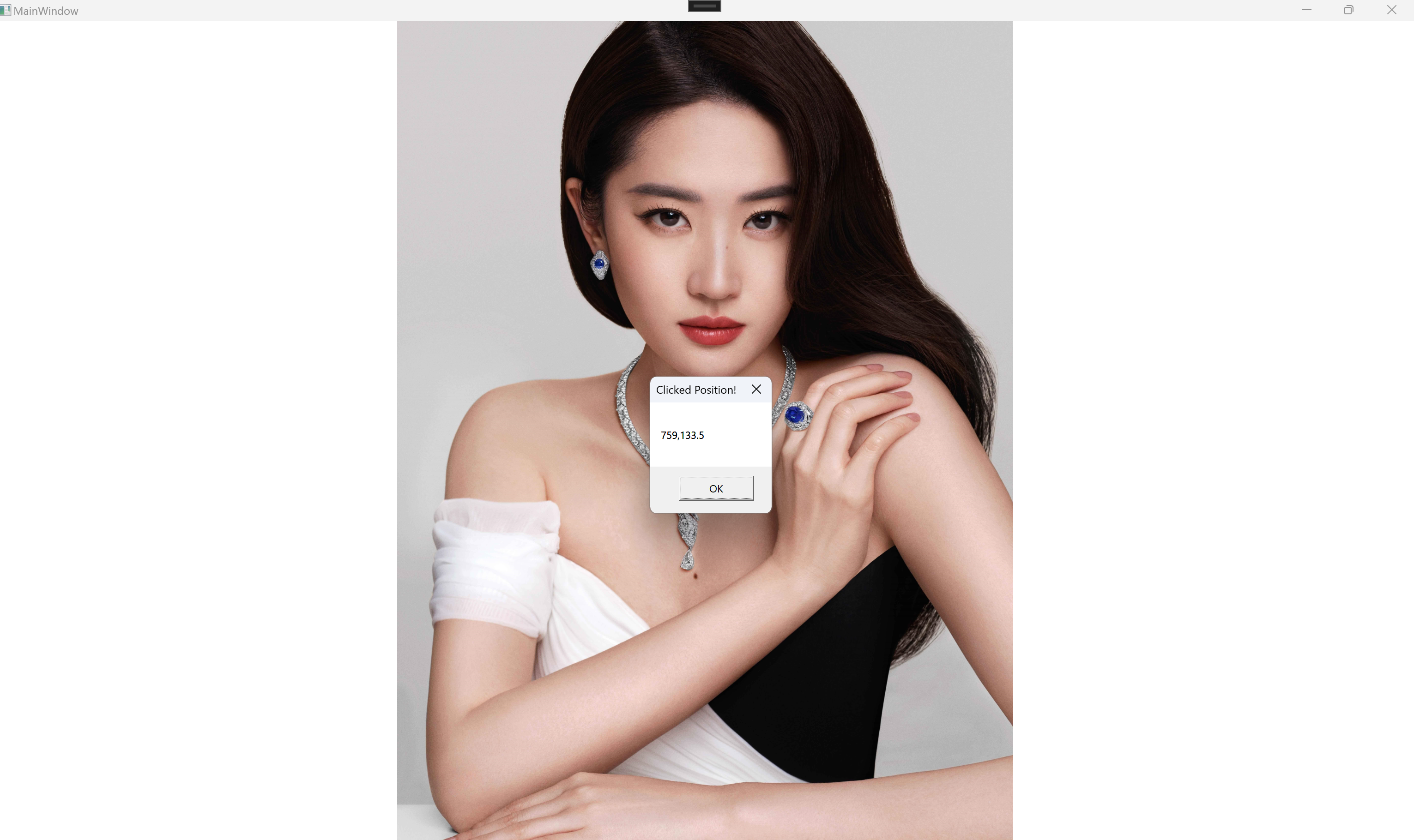WPF Click Window show XY coordinates in MVVM via InvokeCommandAction of behavior
1.Install Microsoft.Xaml.Behaviors.Wpf

2.
<behavior:Interaction.Triggers>
<behavior:EventTrigger EventName="MouseDown">
<behavior:InvokeCommandAction
Command="{Binding ClickCommand}"
CommandParameter="{Binding RelativeSource={RelativeSource Mode=FindAncestor,
AncestorType={x:Type Window}}}"/>
</behavior:EventTrigger>
</behavior:Interaction.Triggers>
//cs
private void InitCommands()
{
ClickCommand = new DelCmd(ClickCommandExecuted);
}
private void ClickCommandExecuted(object obj)
{
var win = obj as Window;
if (win != null)
{
var pt = Mouse.GetPosition(win);
MessageBox.Show($"{pt.X},{pt.Y}", "Clicked Position!");
}
}
public DelCmd ClickCommand { get; set; }


xaml
//xaml <Window x:Class="WpfApp1.MainWindow" xmlns="http://schemas.microsoft.com/winfx/2006/xaml/presentation" xmlns:x="http://schemas.microsoft.com/winfx/2006/xaml" xmlns:d="http://schemas.microsoft.com/expression/blend/2008" xmlns:mc="http://schemas.openxmlformats.org/markup-compatibility/2006" xmlns:local="clr-namespace:WpfApp1" xmlns:behavior="http://schemas.microsoft.com/xaml/behaviors" mc:Ignorable="d" WindowState="Maximized" Title="MainWindow" Height="450" Width="800"> <behavior:Interaction.Triggers> <behavior:EventTrigger EventName="MouseDown"> <behavior:InvokeCommandAction Command="{Binding ClickCommand}" CommandParameter="{Binding RelativeSource={RelativeSource Mode=FindAncestor, AncestorType={x:Type Window}}}"/> </behavior:EventTrigger> </behavior:Interaction.Triggers> <Window.Resources> <SolidColorBrush Color="Cyan" x:Key="imgBg"/> </Window.Resources> <Window.DataContext> <local:BookVM/> </Window.DataContext> <Grid> <Image Source="/Images/1.jpg" RenderOptions.BitmapScalingMode="Fant"/> </Grid> </Window> //cs using System; using System.Collections.Generic; using System.Linq; using System.Text; using System.Threading.Tasks; using System.Windows; using System.Windows.Controls; using System.Windows.Data; using System.Windows.Documents; using System.Windows.Input; using System.Windows.Media; using System.Windows.Media.Imaging; using System.Windows.Navigation; using System.Windows.Shapes; namespace WpfApp1 { /// <summary> /// Interaction logic for MainWindow.xaml /// </summary> public partial class MainWindow : Window { public MainWindow() { InitializeComponent(); } } public class BookVM { public BookVM() { InitCommands(); } private void InitCommands() { ClickCommand = new DelCmd(ClickCommandExecuted); } private void ClickCommandExecuted(object obj) { var win = obj as Window; if (win != null) { var pt = Mouse.GetPosition(win); MessageBox.Show($"{pt.X},{pt.Y}", "Clicked Position!"); } } public DelCmd ClickCommand { get; set; } } public class DelCmd : ICommand { public event EventHandler CanExecuteChanged { add { CommandManager.RequerySuggested += value; } remove { CommandManager.RequerySuggested -= value; } } private Action<object> execute; private Predicate<object> canExecute; public DelCmd(Action<object> executeValue, Predicate<object> canExecuteValue) { execute = executeValue; canExecute = canExecuteValue; } public DelCmd(Action<object> executeValue) : this(executeValue, null) { } public bool CanExecute(object parameter) { if (canExecute == null) { return true; } return canExecute(parameter); } public void Execute(object parameter) { execute(parameter); } } }
分类:
wpf






【推荐】国内首个AI IDE,深度理解中文开发场景,立即下载体验Trae
【推荐】编程新体验,更懂你的AI,立即体验豆包MarsCode编程助手
【推荐】抖音旗下AI助手豆包,你的智能百科全书,全免费不限次数
【推荐】轻量又高性能的 SSH 工具 IShell:AI 加持,快人一步
· 分享一个免费、快速、无限量使用的满血 DeepSeek R1 模型,支持深度思考和联网搜索!
· 基于 Docker 搭建 FRP 内网穿透开源项目(很简单哒)
· ollama系列01:轻松3步本地部署deepseek,普通电脑可用
· 25岁的心里话
· 按钮权限的设计及实现